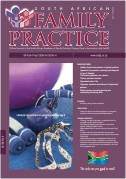Type 2 Diabetes: Primary Health Care Approach for Prevention, Screening and Diagnosis in South Africa
Keywords:
diabetes prevention, diabetes screening, diabetes diagnosis
Abstract
We have reviewed large studies that demonstrate different methods that have been adopted to prevent or delay the progression to Type 2 diabetes in high-risk individuals. The principal interventions include behavioural modifications in diet and physical activity, use of insulin sensitisers such as metformin and glitazones, and alpha-glucosidase inhibitors. Although there is no evidence of benefit in health outcomes from large-scale population screening for impaired glucose tolerance (IGT) or impaired fasting glucose (IFG), screening of high-risk individuals has merit. During prolonged periods of dysglycaemia that precede diabetes, individuals remain largely asymptomatic. These periods can be from 8-10 years as extrapolated from the United Kingdom Prospective Diabetes Study data. This phase of pre-diabetes is not innocuous, and is often associated with the concurrent development of complications, which highlights the importance of early detection and treatment of this ‘silent killer’. Although different methods for screening of diabetes are available, preferred techniques include measurement of fasting plasma glucose and 2 hr post-load plasma glucose. People should be encouraged to eat correct diets, be active, and maintain a healthy weight - these behaviours have other benefits in addition to preventing or delaying the onset of Type 2 diabetes. There are various diagnostic criteria used for the diagnosis of diabetes. In this article we have presented two sets of criteria, one from the World Health Organization (WHO) and the other from the American Diabetes Association (ADA).
Published
2008-07-10
Section
CPD
By submitting manuscripts to SAFP, authors of original articles are assigning copyright to the South African Academy of Family Physicians. Copyright of review articles are assigned to the Publisher, Medpharm Publications (Pty) Ltd, unless otherwise specified. Authors may use their own work after publication without written permission, provided they acknowledge the original source. Individuals and academic institutions may freely copy and distribute articles published in SAFP for educational and research purposes without obtaining permission.

